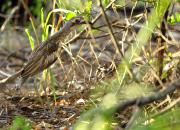info
The behavior of the Bush Stone-curlew is quite amusing and different. The hardest task is to spot him. But when you succeed you need the telephoto lens more to reduce its anxiety caused by our presence than to be helpful in taking the picture. It happened to me several times to observe the Bush Stone-curlew. Scenario was always the same. The bird knew about my presence long before and sat with no one move thinking that is invisible to me. I was changing the position of the tripod quietly and methodically, until the curlew filled the frame. In Australia birds probably are not disturbed since it is possible to come so close to them. I could not see the Bush Stone-curlew in flight as it always was going away leisurely, and did not take its wings off. Its calm and serious look is amazing. Such restraint may be due to the fact that curlews are more active at night, when they prey on frogs and insects.
Australia - wykaz j.angielski
A U S T R A L I A – introduction text - A U S T R A L I A N B U S T A R D
News gallery birds:
1.Australian bustard.2.Emu.3.Red-tailed Black-Cockatoo.4.White-faced Heron.5.Brolga.6.Green Figbird.7.Zebra Finch.8.Rainbow Lorikeet.9.Pheasant Coucal.10.Australian Pelican.11.Olive-backed Sunbird.12.Yellow Honeyeater.13.Apostlebird.14.Magpie Goose.15.Superb Fairywren. 16.Sulphur-crested Cockatoo.17.Noisy Friarbird.18.Straw-necked Ibis.19.Welcome swallow.20.Black Kite.21.Gala. 22.Plumed Whistling Duck.23.Dollarbird.24.Sacred Kingfisher.25.Masked Lapwing.26.Varied triller.27.Little friarbird. 28.Black-shouldered Kite.29.Laughing Kookaburra.30.Comb-crested jacana.31.Sharp-tailed sandpiper.32.Red-whiskered Bulbul.33.Peaceful Dove. 34.Bush stone curlew. 35.White-throated honeyeater.36.Australian Brushturkey.37.Noisy miner.38.New Holland Honeyeater. 39.Crimson Finch. 40.White-breasted Woodswallow.41.Australian King Parrot.42.Australian Wood Duck.43.Great Bowerbird.44.Little Pied Cormorant.45.Black-billed Koel.46.Australian Raven.47.Spangled drongo.48.Spiny-cheeked honeyeater.49.Willie Wagtail.50.Wedge-tailed Eagle.51.Common Myna.52.Lewin's Honeyeater.53.Eastern Spinebill.54.Chestnut-breasted Munia.55.Rainbow Bee-eater. 56.Blue-winged Kookaburra.57.Common bronzewing.58.Wandering whistling duck.59.Helmeted Friarbird.60.Crested Pigeon.61.Pied Currawong.62.Brown-backed honeyeater.63.Yellow-faced honeyeater.64.Grey-headed honeyeater.65Yellow-throated miner.66.Scaly-breasted munia.67.Masked Woodswallow.68.Hardhead.69.Pale-headed Rosella.70.Blue-faced Honeyeater.71.Grey Butcherbird.72.Australian magpie.73.Whistling kite.74.Black Swan.75.Royal Spoonbill.76.Double-barred Finch.77.Broad-billed Flycatcher.78.Australian Swamphen.79.Brown Falcon.80.Pied Butcherbird.81.White-browed scrubwren.82.Silvereye.83.Rufous-throated Honeyeater.84.Black-faced Cuckooshrike. 85.Red backed fairywren.86.Pacific black duck. 87.Magpie-lark. 88.Red winged parrot.89.Zitting Cisticola.90Cotton Pygmy Goose.91.Pallid Cuckoo. 92.Australian Kestrel.93.Crimson Rosella.94.Forest Kingfisher.95.Australian coot.96.Red-browed Finch.97.Australian White Ibis.98.Australasian Darter.99.Pied oystercatcher.100.Striated Heron.101.Cattle Egret.102.Great Egret.103.Intermediate Egret.104.Sooty Oystercatche.105.Green pygmy goose.106.Brush Wattlebird.107.White-heded Stilt.
News gallery reptiles:
1.Yellow Spotted Monitor. 2. Eastern blue-tongued lizard. 3.Jewel Rainbow. 4.Sand Monitor. 5.Nobbi Dragon. 6.Saw-shelled turtle.
News gallery mammals:
1. Dingo. 2. Flying fox. 3. Agile wallaby. 4. Eastern grey kangaroo. 5.Common wallaroo. 6.Whiptail Wallaby.
Go to the gallery: A U S T R A L I A – F A U N A


